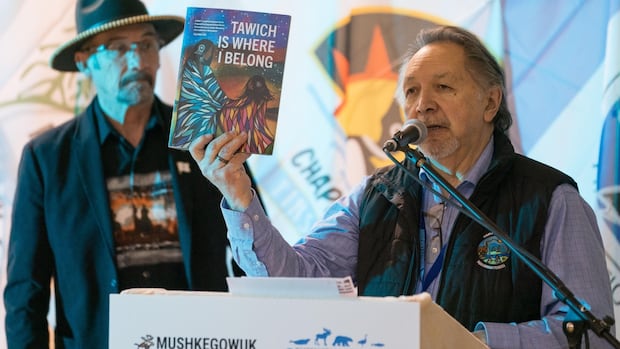Ontario pipeline corridor proposal faces pushback over lack of Indigenous consultation, environmental risks

Note: This is the second story in a three-part look at the East-West Energy Corridor project. You can read the initial story here.
A group representing seven First Nations in northern Ontario says the province’s push for a cross-country pipeline is moving ahead without their voices and is in conflict with federally funded conservation work already underway.
If approved, the East-West Canadian Energy Corridor would carry oil and gas from Alberta to refineries in southern Ontario.
But Lawrence Martin, lands and resources director for the Mushkegowuk Council, is frustrated that the province has not yet met with the council or the seven First Nation communities it represents, even though projects are being proposed on their territory along the James Bay coast.
“It’s as if we’re invisible throughout this whole discussion, everything that’s happening in the territory on the land or on the water. So it’s quite amazing,” Martin said.
Ontario Premier Doug Ford said the corridor is a nation-building project meant to strengthen energy security and boost exports, in part to respond to U.S. economic threats such as tariffs.
The province also wants to explore the idea of new port outlets on James Bay, Hudson Bay, and the Great Lakes, according to a news release this month. It has tied the proposed project to its broader push for critical mineral development in the north, and its effort to position the province as a hub for energy and manufacturing.
Ford has said the corridor would bring thousands of jobs and attract global investment.
Ontario has promised to “develop an Indigenous engagement roadmap” while studying the pipeline proposal, but Martin dismissed that as “lip service.”
He said he only learned of the province’s request for proposals, to study the feasibility of the energy corridor, when contacted by CBC.
CBC also reached out to Ford’s office and the office of George Pirie, minister of northern economic development and growth, for comment.
“The recent request for proposals is an initial step in determining the feasibility of energy corridors and new trade infrastructure across the province,” Sam McCormick, a spokesperson for Pirie, said in a statement.
“Our government has begun productive conversations with First Nations communities who share the vision of unlocking economic opportunity and critical infrastructure in their communities. These meetings with First Nation communities will directly inform the development and next steps of these nation-building projects,” it said.
Conflict with conservation work
Martin said Ontario’s interest in a deep-sea port on James Bay clashes with research the council has conducted with Parks Canada. Those studies, aimed at establishing national marine conservation areas (NMCAs), indicate the coast is unsuitable for large shipping infrastructure due to shallow waters, tides, and ice cover.
In December 2022, the federal government announced it would commit $800 million to support four major Indigenous-led marine conservation projects across Canada.
The proposed marine conservation area on the James Bay and Hudson Bay was one of them. It would cover a 91,000-square-kilometer area along the southwestern shorelines of James Bay and north along Hudson Bay.
Martin said Mushkegowuk Council recently re-entered negotiations with Parks Canada.
“The feasibility study is done and we have determined through that study that it is feasible to have an NMCA in James Bay and Hudson Bay.
“Now we have to start negotiating with the federal government on what the operations would look like and how we would have the Indigenous-led conservation ideas merged into the existing policies of the federal government,” said Martin, who thinks an agreement could be finalized in the next year.
Ontario’s corridor plan, Martin argued, undermines that federal work.
“It’s a contradicting situation for the federal government. They’re funding the feasibility study to establish a national marine conservation area, and specifically some of the ‘do not do these things’ include dredging. Dredging is part of the rules of having an NMCA in place.”
He hopes the community’s ideas will be incorporated in establishing any NMCA.
“But however the outcome, it’s probably going to be the same as what we’re seeing here from a common-sense logistical perspective. James Bay is not that kind of body of water that would accommodate deep sea.”
James Bay is within tidal waters, with tides coming in roughly every five to six hours, moving the earth on the bottom of the sea. Martin said if there’s any kind of dredging, it would have to be continuous. It would also have to address the ice that’s on James Bay.
Morning NorthPremier Doug Ford wants to build a deep-sea port on James Bay
A deep-sea port on the remote coast of James Bay could help transform Canada’s economy according to Ontario Premier Doug Ford. But First Nations and local leaders say the water isn’t deep enough and they were never consulted. The CBC’s Faith Greco joined us with that story.
“We were just out there about a month ago, and there’s still lots of ice out on James Bay and certainly a lot of ice in Hudson Bay. So you’re talking about ice breakers and so forth, so it’s going to be a lot of disturbance. …
Marie. The project aims to enhance marine, freshwater, and coastal incident response tools.
The potential risks associated with the proposed energy corridor have raised concerns among scientists and environmentalists. Mike McKay, the director of the Great Lakes Institute for Environmental Research at the University of Windsor, expressed his apprehension about the project’s impact on the Great Lakes.
“It’s always a concern when we are digging into our natural resources and when that can actually have ecological impacts on other natural resources such as our Great Lakes,” McKay said. He emphasized the significance of the Great Lakes as a vital source of freshwater for millions of people and a key economic driver in the region.
McKay highlighted the limited understanding of how oil behaves in freshwater environments, underscoring the need for further research to assess the potential consequences of an energy corridor near the Great Lakes. The ongoing project funded by Natural Resources Canada aims to investigate the effects of oil spills in freshwater ecosystems and develop improved incident response strategies.
The concerns raised by McKay and other experts underscore the importance of thorough environmental assessments and community consultations before proceeding with large-scale infrastructure projects like energy corridors. As discussions and consultations continue, it is essential to prioritize environmental protection and sustainable development to safeguard vital ecosystems like the Great Lakes for future generations. The town of Marie, Mich. is taking proactive steps to prepare for potential environmental disasters, such as oil spills in wetland environments. One innovative approach being utilized is the construction of mesocosms – small, human-made ecosystems that mimic natural ecosystems on a smaller scale. These mesocosms are used for scientific research to simulate the effects of an oil spill in a wetland setting.
Simulations have been conducted in the past fall and summer, with another one planned for this upcoming fall. This preparation is crucial given the presence of pipelines that traverse the Great Lakes and potential plans for more pipelines within the basin. It is important for communities to be prepared for any potential environmental risks that may arise.
The Mushkegowuk Council has been actively seeking meaningful dialogue with the Ontario government to discuss the studies that have been conducted and to advocate for the establishment of James Bay as a National Marine Conservation Area (NMCA) through the federal government. Despite repeated attempts to initiate discussions with the Ontario government, progress has been slow.
The Mushkegowuk Council represents various First Nations communities along the coast of James Bay, including Moose Cree First Nation, Fort Albany First Nation, Attawapiskat First Nation, and others. These communities are deeply invested in conservation efforts and have valuable knowledge to contribute to the conversation about the suitability of James Bay for a seaport.
It is essential for the province to engage with the Mushkegowuk Council and other First Nations communities to ensure that their voices are heard and their perspectives are considered in decision-making processes. Collaboration and cooperation between all stakeholders are crucial in protecting the environment and preserving the well-being of both people and animals in the region.



